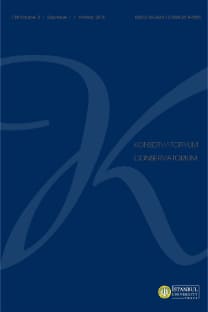Makrokosmos I: George Crumb’in Eserinde Gelişmiş Piyano Teknikleri
Crumb, Makrokosmos, Gelişmiş Piyano Teknikleri
Makrokosmos I: Extended Piano Techniques in George Crumb’s Work
Crumb, Makrokosmos, Extended Piano Techniques,
___
- Bass, R. (1991). Set, Scales and Symmetries: The Pitch Structural Basis of George Crumb Makrokosmos I and II. Music Theory Spectrum, Volume 13, No: 1, 1-20. Erişim adresi: http://www.jstor.org/stable/745971
- Burge, D. (1990). Twentieth Century Piano Music. New York: Schirmer Books.
- Burge, D. (1976). Performing The Piano Music Of George Crumb. Contemporary Keyboard,II/4, 20-21. Erişim adresi: https://core.ac.uk/download/pdf/215269034.pdf
- Cohen, D. (2002). George Crumb A Bio-Bibliography, Bio-bibliographies in Music. London, Westport, Connecticut: Greenwood Publishing Group.
- Crumb, G. (1974). Makrokosmos, Volume I-II for Amplified Piano. New york: C.F. Peters.Crumb, G. (1971). Songs, Drones and Refrains of Death. Newyork: C.F. Peters.
- Crumb, G. (1974). George Crumb Makrokosmos Volume I, Notes for Vinyl Record. Kaliforniya,Nonesuch Records.
- Duffie, B. (1998). Interview with George Crumb, “Composer George Crumb”, A Conversation with Bruce Duffie, WNIB, Classical 97. Chicago, Erişim adresi: http://www.bruceduffie.com/crumb2.html
- Hanehan, D. (1975, Mayıs 11). Crumb, The Tone Poet. The New York Times. Erişim adresi: https://www.nytimes.com/1975/05/11/archives/crumb-the-tone-poet-crumb.html
- Matthews, N. W. (1981). George Crumb’s Makrokosmos Volume I and II: Considerations for performance, Inclu-ding Observations by David Burge, Robert Miller and Lambert Orkis (Doktora tezi, University of Oklahoma School of Music, Norman). Erişim adresi: https://core.ac.uk/download/pdf/215269034.pdf
- Pearsall, E. (2004). Symmetry and Goal Directed Motion In Music By Bela Bartok And George Crumb. Tempo 58, 228, 32-40. doi: 10.1017/S0040298204000129
- Shuffett, R. (1979). The Music, 1971-75, of George Crumb: A Style Analysis. Erişim adresi: https://books.google.com.tr/books
- Vaes, L. P. F. (2009). Extended Piano Techniques: in theory, history and performance practice (Doktora tezi, Faculty of Humanities, Leiden Üniversitesi, Leiden). Erişim Adresi: https://openaccess.leidenuniv.nl/handle/1887/15093
- ISSN: 2146-264X
- Yayın Aralığı: 2
- Başlangıç: 2011
- Yayıncı: İstanbul Üniversitesi Devlet Konservatuvarı
Müziğin Ruhani Niteliklerine Yönelik Üç Bakış Açısı
D. Shostakovich Viyola Sonati Op.147 Üzerine Teknik Açidan Bir İnceleme
Sonat Teorisi Yaklaşımıyla Bir Aşk Mektubunun Analizi: R. Schumann, Op.11/I
Sonat Teorisi Üzerinden Bir Aşk Mektubunun Analizi: R. Schumann, Piyano Sonatı, No. 1, Op. 11/I
Makrokosmos I: George Crumb’in Eserinde Gelişmiş Piyano Teknikleri
